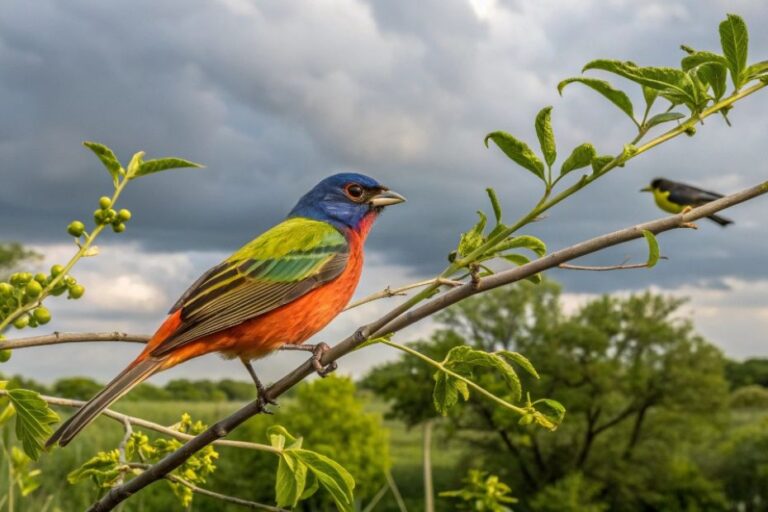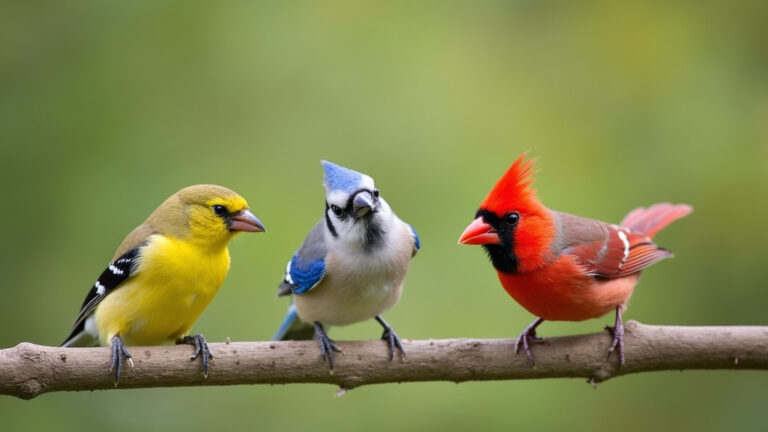About Sandhill Cranes: Fascinating Facts & Migration Secrets
Sandhill Cranes are large, elegant birds known for their graceful movements and distinctive calls. They thrive in wetlands across North America.
Sandhill Cranes stand out with their tall stature, long legs, and striking red crowns. These birds migrate seasonally, often traveling thousands of miles between breeding and wintering grounds.
They gather in large flocks, creating spectacular displays during migration periods. Their diet mainly consists of plants, grains, and small animals, making them versatile feeders.
Conservation efforts have helped stabilize some Sandhill Crane populations, although habitat loss remains a concern. Observing these majestic birds in their natural habitat offers a unique glimpse into their complex social behaviors and impressive adaptability.
Sandhill Cranes continue to captivate bird enthusiasts and researchers alike.
Introduction To Sandhill Cranes
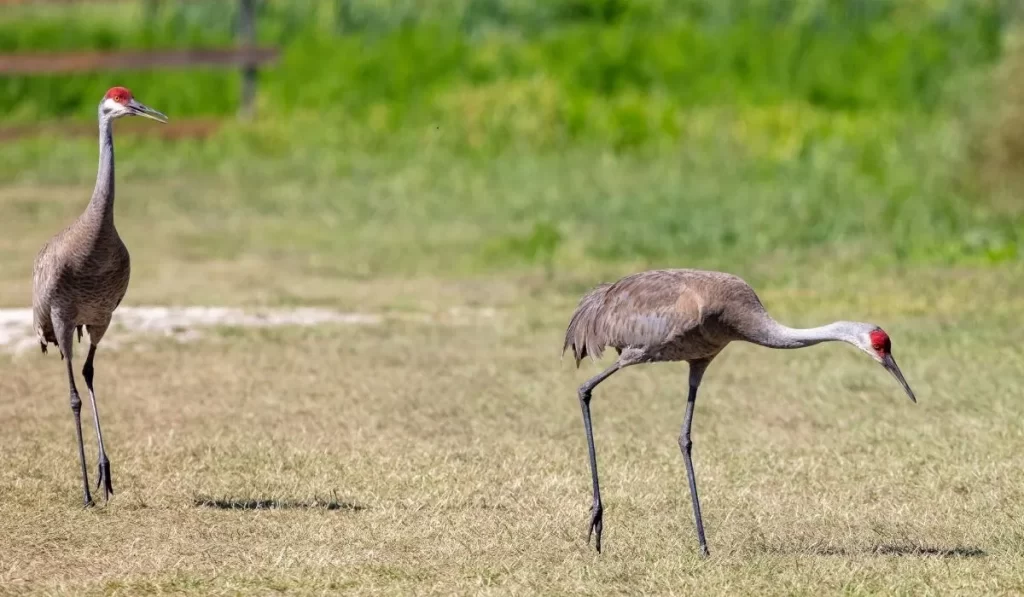
Sandhill Cranes are large, elegant birds. They are found in North America. These birds have long legs and necks. They are known for their graceful movements and loud calls.
Majestic Birds
Sandhill Cranes stand out with their majestic appearance. They have grey feathers and a distinctive red crown. Their wingspan can reach up to seven feet.
These birds are often seen in pairs or small groups. They perform beautiful dances during mating season. Their dances include bowing, jumping, and wing-flapping.
Sandhill Cranes are strong fliers. They migrate long distances, traveling up to 400 miles in a day. They use thermal currents to soar high in the sky.
Historical Significance
Sandhill Cranes have a rich history in North America. Native American cultures revered these birds. They appear in many legends and stories.
Early settlers also admired Sandhill Cranes. They considered them symbols of longevity and good fortune. Today, these birds continue to be a source of inspiration.
Conservation efforts have helped protect Sandhill Cranes. Their populations are now stable and growing. These efforts ensure future generations can enjoy these magnificent birds.
Physical Characteristics
Sandhill Cranes are fascinating birds with unique physical traits. They are known for their large size and distinctive feather patterns. Let’s explore their physical characteristics in detail.
Size And Weight
Sandhill Cranes are among the tallest birds in North America. They typically stand about 3 to 4 feet tall. Their wingspan can reach up to 7 feet.
Adult Sandhill Cranes weigh between 6 to 12 pounds. Males are usually larger than females. Their long legs and necks make them look even taller.
Feather Patterns
Sandhill Cranes have gray feathers that sometimes appear rusty-brown. This color comes from preening with iron-rich mud. Their feathers are soft and smooth, providing excellent insulation.
They also have a distinctive red patch on their forehead. This patch is bare skin, not feathers. It becomes brighter during the mating season.
Juvenile Sandhill Cranes have brownish-gray feathers. They lack the red forehead patch seen in adults. Their feathers change color as they mature.
Here’s a quick summary in table form:
| Characteristic | Description |
|---|---|
| Height | 3 to 4 feet |
| Wingspan | Up to 7 feet |
| Weight | 6 to 12 pounds |
| Feather Color | Gray, sometimes rusty-brown |
| Forehead Patch | Red |
| Juvenile Feathers | Brownish-gray |
Behavior And Social Structure
Sandhill Cranes are fascinating birds. They exhibit unique behaviors and strong social bonds. These behaviors include complex mating dances and tight family units. Let’s explore their social life.
Mating Rituals
Mating rituals of Sandhill Cranes are elaborate and beautiful. They perform intricate dances to attract mates.
- Bow: They bow to each other.
- Leap: They leap high into the air.
- Call: They produce loud, harmonious calls.
- Display: They fluff their feathers and spread their wings.
These dances strengthen their bond and ensure a successful pairing.
Family Bonds
Sandhill Cranes have strong family bonds. They stay together in close-knit groups.
| Family Member | Role |
|---|---|
| Parents | Protect and teach young cranes. |
| Chicks | Learn survival skills from parents. |
Parents are very protective of their chicks. They teach them important survival skills. Chicks learn how to find food and stay safe.
As they grow, young cranes stay with their parents. They form strong family bonds that last a lifetime.
Habitat And Range
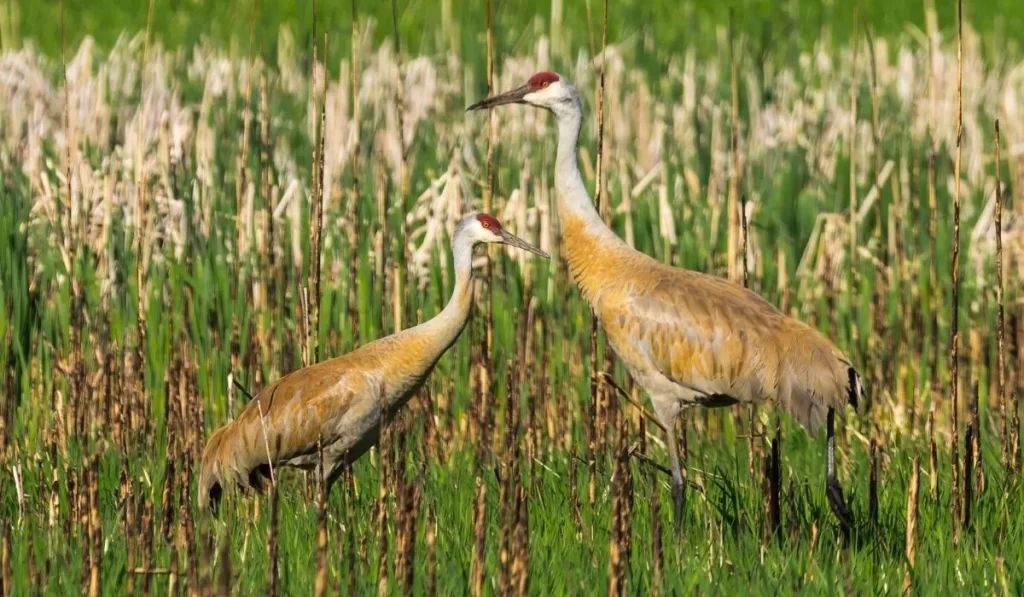
Sandhill Cranes are fascinating birds known for their elegance and grace. Understanding their habitat and range helps us protect these magnificent creatures. In this section, we will delve into their preferred environments and geographical spread.
Preferred Environments
Sandhill Cranes thrive in wetlands. They favor marshes, swamps, and bogs. These areas provide ample food and nesting sites. Grassy fields and prairies also serve as ideal habitats. They offer open space for nesting and foraging.
During migration, Sandhill Cranes rest in agricultural fields. These fields supply grains and other food sources. Forest edges are another habitat they utilize. Here, they find shelter from predators and harsh weather.
| Preferred Environment | Details |
|---|---|
| Wetlands | Marshes, swamps, bogs |
| Grassy Fields | Open space for nesting and foraging |
| Agricultural Fields | Resting and feeding during migration |
| Forest Edges | Shelter from predators and weather |
Geographical Spread
Sandhill Cranes have a wide geographical spread. They can be found across North America. Some populations are also present in Cuba and northeastern Siberia.
In North America, they breed in Canada and the northern United States. They migrate to the southern United States and Mexico during winter. A notable stopover site is Nebraska’s Platte River. Thousands of cranes gather here each spring.
Cuban Sandhill Cranes are non-migratory. They live year-round in Cuba’s wetlands. The Lesser Sandhill Crane breeds in Siberia. They migrate to China and Japan for winter.
- North America: Canada and Northern USA (Breeding); Southern USA and Mexico (Wintering)
- Cuba: Year-round in wetlands
- Siberia: Breeding; China and Japan (Wintering)
Diet And Feeding Habits
Sandhill Cranes are fascinating birds with diverse diets. They adapt to their environment for food. Understanding their diet and feeding habits sheds light on their survival.
Plant-based Diet
Sandhill Cranes primarily consume a plant-based diet. They eat various types of grains, seeds, and berries. Corn, wheat, and oats are common choices. They also enjoy foraging for roots and tubers. These foods provide essential nutrients.
During migration, they stop in fields. Here, they feast on leftover crops. This behavior helps them gain energy for long journeys.
Foraging Techniques
Sandhill Cranes have unique foraging techniques. They often forage in shallow water. They use their long bills to probe for food. This helps them find aquatic plants and small animals.
The cranes also forage in open fields. They walk slowly, pecking at the ground. This method allows them to find insects and small vertebrates. Their sharp eyesight aids in spotting food from a distance.
Here is a table summarizing their foraging techniques:
| Habitat | Technique | Food Source |
|---|---|---|
| Shallow Water | Probing | Aquatic Plants, Small Animals |
| Open Fields | Slow Walking | Insects, Small Vertebrates |
Sandhill Cranes demonstrate excellent adaptability. Their diet and foraging habits ensure they thrive in various environments.
Vocalizations And Communication
Sandhill Cranes are known for their distinctive vocalizations. These birds use sounds to communicate with each other. Their calls are important for their social interactions and survival.
Unique Calls
Sandhill Cranes have a variety of unique calls. These calls can be loud and piercing. Chicks make soft purring sounds. Adults produce more complex calls.
One of their most famous calls is the unison call. This call is often heard during mating season. Both males and females participate in this call. It helps them strengthen their bond.
Meaningful Sounds
Each sound made by Sandhill Cranes has a specific meaning. They use calls to warn of danger. They also use sounds to keep the flock together. Different calls are used for different purposes.
Below is a table showing some common sounds and their meanings:
| Sound | Meaning |
|---|---|
| Unison Call | Bonding and Mating |
| Alert Call | Warning of Danger |
| Contact Call | Keeping Flock Together |
These meaningful sounds are crucial for Sandhill Cranes. They help them survive and thrive in their environment.
Read More: Impact of Climate Change on Birds
Migration Patterns
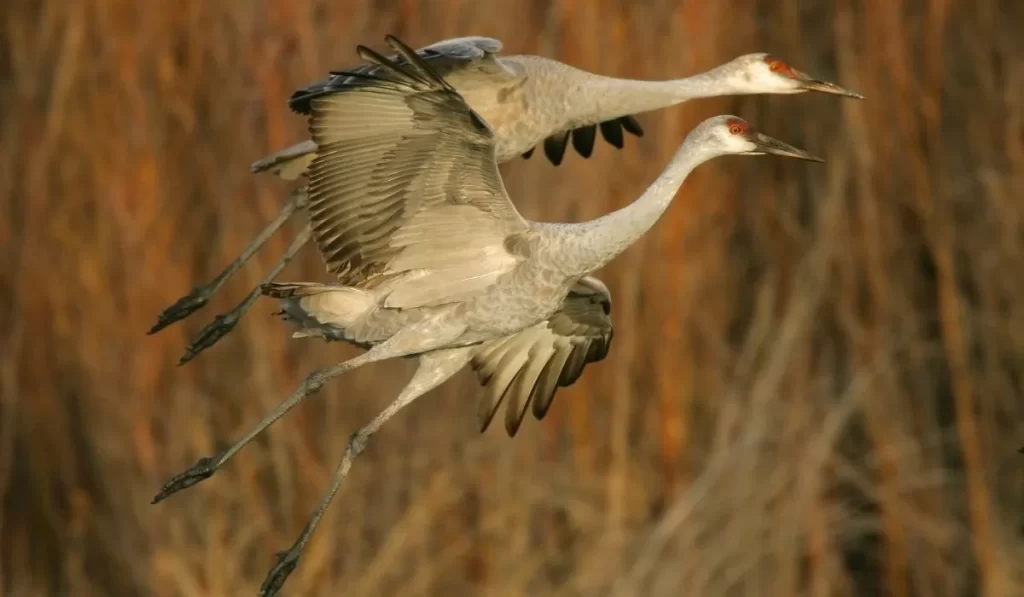
Sandhill Cranes are known for their spectacular migration journeys. They travel thousands of miles twice a year. These majestic birds follow specific routes and timings.
Routes And Distances
Sandhill Cranes take well-known migration routes. One popular route is the Central Flyway. This path stretches from Canada to Mexico.
Another route is the Pacific Flyway. Birds in this group travel from Alaska to California.
The last main route is the Eastern Flyway. These cranes move from the Great Lakes down to Florida.
Here is a table showing the typical distances traveled:
| Route | Distance (Miles) |
|---|---|
| Central Flyway | 2,500 |
| Pacific Flyway | 2,000 |
| Eastern Flyway | 1,500 |
Seasonal Timings
Sandhill Cranes migrate based on the seasons. In the spring, they head north. This journey starts in late February and ends by April.
In the fall, they travel south. This migration begins in late September and finishes by November.
These birds follow the warm weather. They also seek out abundant food sources.
Here is a quick list of their seasonal timings:
- Spring Migration: Late February to April
- Fall Migration: Late September to November
Understanding these patterns helps in conservation efforts. It also allows bird watchers to plan their trips accordingly.
Conservation Efforts
Sandhill cranes are majestic birds that need our help. Their conservation is crucial. Efforts to protect them are ongoing and evolving. Here, we will explore the challenges they face and what is being done to save them.
Threats And Challenges
Sandhill cranes face many threats and challenges in their natural habitats. These include:
- Habitat loss: Wetlands are being drained for agriculture and development.
- Climate change: Altered weather patterns affect their breeding and migration.
- Hunting: In some regions, cranes are hunted for sport.
- Human disturbance: Increasing human activity disrupts their nesting sites.
Protection Initiatives
Several protection initiatives are in place to help sandhill cranes. These efforts include:
- Habitat restoration: Efforts to restore and preserve wetland areas.
- Legal protection: Laws and regulations to protect cranes from hunting.
- Education programs: Raising awareness about the importance of crane conservation.
- Research: Studies to understand crane behavior and needs better.
A table summarizing key protection initiatives:
| Initiative | Description |
|---|---|
| Habitat Restoration | Restoring wetlands and natural habitats. |
| Legal Protection | Implementing laws to prevent hunting. |
| Education Programs | Informing the public about crane conservation. |
| Research | Conducting studies on crane populations. |
These efforts are vital for the survival of sandhill cranes. Every action counts in protecting these beautiful birds.
Cultural Impact
The cultural impact of Sandhill Cranes is vast and significant. These majestic birds have influenced various cultures, art forms, and traditions. They hold special places in stories, dances, and ceremonies.
Symbolism In Art
Sandhill Cranes often appear in paintings, sculptures, and literature. They symbolize grace and beauty. Many artists use their elegant form to depict peace and harmony. In Japanese art, cranes often represent longevity and good fortune.
Here are some common symbols associated with Sandhill Cranes:
- Longevity
- Good fortune
- Peace
- Harmony
Role In Indigenous Cultures
In many Indigenous cultures, Sandhill Cranes play a vital role. They feature in myths, legends, and dances. The cranes are seen as sacred and are often part of creation stories.
For example, the Haudenosaunee people believe cranes bring rain. The Hopi people perform crane dances during their ceremonies. This dance is to honor the bird and its importance to their way of life.
Here is a table summarizing their roles in different cultures:
| Culture | Role |
|---|---|
| Haudenosaunee | Bringers of rain |
| Hopi | Part of ceremonial dances |
These examples show the deep connection between Sandhill Cranes and human culture.
Frequently Asked Questions
What Is Special About A Sandhill Crane?
Sandhill cranes are special for their distinctive red forehead, long legs, and unique, loud trumpeting call. These birds perform elaborate mating dances, showcasing their graceful movements. They also migrate long distances, often flying in large flocks, making them a captivating sight for birdwatchers.
What Does A Sandhill Crane Eat?
A sandhill crane eats seeds, grains, berries, insects, small mammals, and amphibians. It forages in fields, marshes, and wetlands.
Do Sand Cranes Mate For Life?
Yes, sandhill cranes typically mate for life. These birds form strong, lasting bonds with their partners. They often stay together year-round and engage in synchronized behaviors.
What Is The Mating Behavior Of The Sandhill Crane?
Sandhill cranes perform elaborate courtship dances. They leap, bow, and flap their wings. Pairs mate for life, often returning to the same nesting site.
Conclusion
Sandhill Cranes captivate with their grace and beauty. They play a vital role in ecosystems. These birds showcase nature’s splendor. Protecting their habitats ensures future generations can enjoy them. Learning about Sandhill Cranes deepens our connection to the natural world.
Appreciate and respect these magnificent creatures for a richer experience.
Reference:
Sandhill Crane – U.S. National Park Service
Sandhill Crane (Grus canadensis) | U.S. Fish & Wildlife Service



